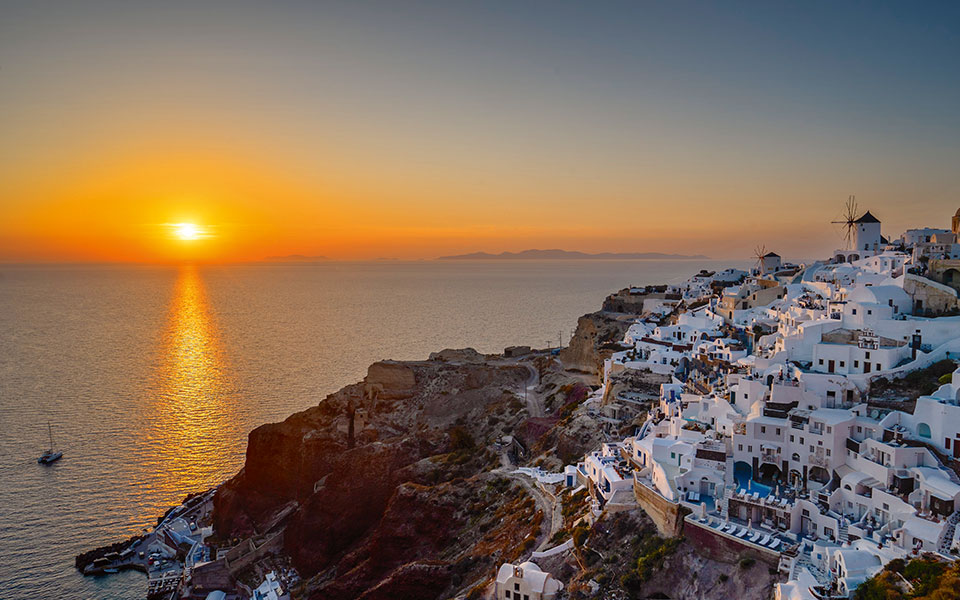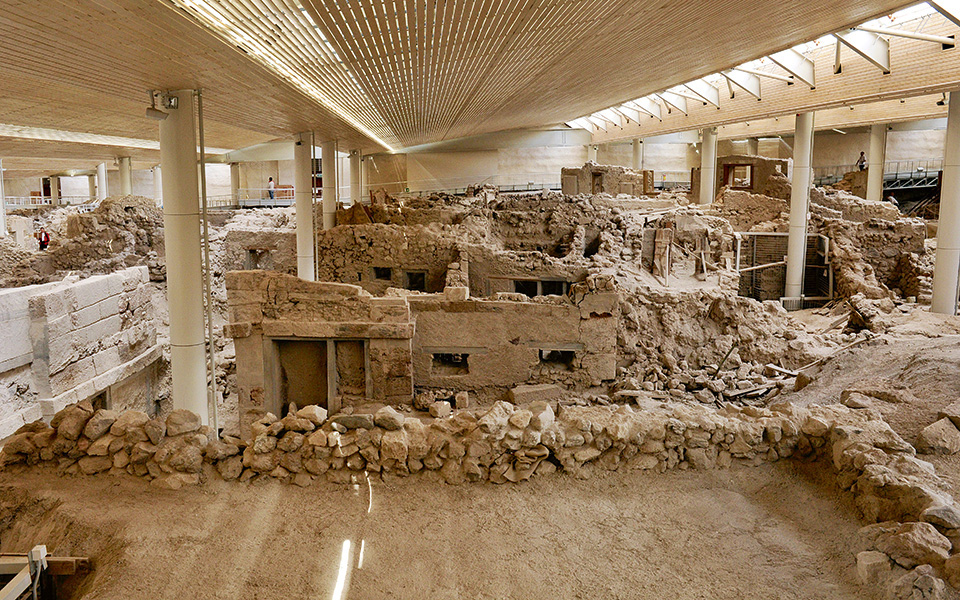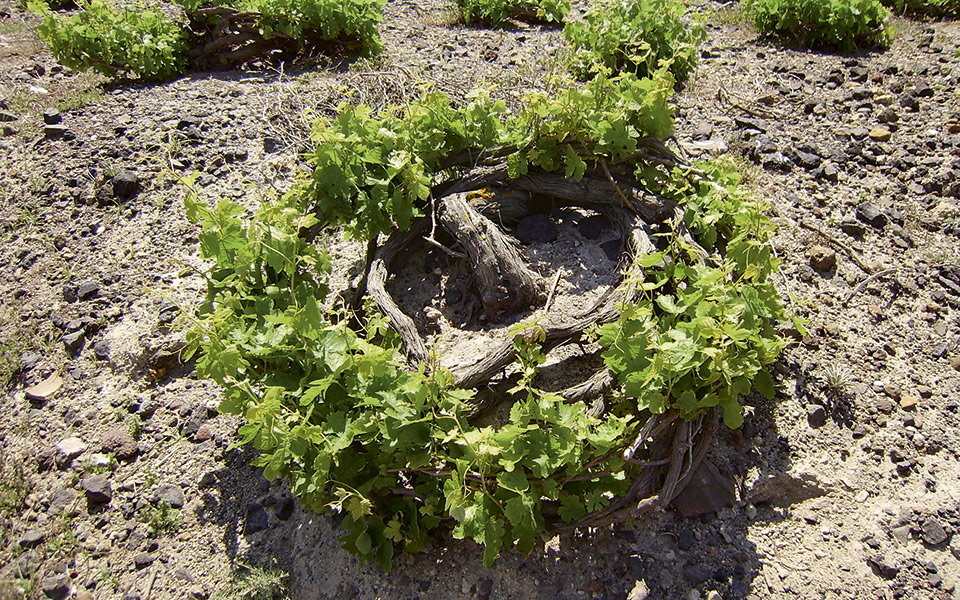Aigai: The Mysteries of Philip II’s Restored Palace
Aigai’s newly restored Macedonian palace represents...

The famous Santorinian sunset.
© Perikles Merakos
It causes some to laugh: when the sun sinks into the sea behind Santorini’s caldera, many in the obligatory crowd of onlookers burst into applause – sort of like when a pilot lands his plane, though even sillier, because what possible creator responsible for the sunset would pay attention to the applause of honeymooners in Greece?
But while this daily ripple of applause may seem illogical – one suspects the sun will set with or without an audience – it is understandable why many are moved to express their appreciation for this admittedly gorgeous spectacle, arguably the most famous of the Cyclades.
The sunshine – the light that glitters in the sea, dazzles against the whitewashed houses and bakes the arid rocks of the Cyclades, is, many would say, the very soul of this island group.

Paros
© Clairy Moustafellou

Naxos
© Clairy Moustafellou

Kythnos
© Perikles Merakos
While efforts to promote other destinations in Greece have been undeniably successful, the Cyclades are still the Greece you picture in your mind: narrow labyrinthine alleys between sugar cube-like houses drenched in sun, courtyards dotted with splashes of color from potted plants and bougainvillaea, cats lazily grooming themselves in the shade – and all of this clinging to a rocky hillside above a glistening sea.
But these charming images aside, it is light, above all else, that has shaped the islands into what they are today.

A tourist protects himself from the almost blinding sun at the archeological site on Delos.
© Shutterstock

Jackie Kennedy on Mykonos.
© Mondadori, Bettmann, James Burke /LIFE, Keystone / Getty Images / Ideal Image

An advertisement for Olympic Airways, 1966.
© GNTO
When Greece came into its “golden age” of tourism, in the 1950s-60s, the Cyclades were already at the forefront, making islands like Mykonos an established option for A-listers like Grace Kelly and Sophia Loren, as well as Aristotle Onassis, who brought both Maria Callas and Jackie Kennedy. These luminaries helped further raise the profile of the Cyclades ensuring they were at the top of many a Greek itinerary.
But foreign visitors actually began arriving on Mykonos earlier than that, back in the 1930s, drawn by the increased interest in the archaeological site of Delos; the sacred uninhabited island, in other words, became the igniting, if somewhat slow-burning, spark for the tourism boom.
And this, in a way, was merely a reprisal of Delos’ role millennia ago. Known in the Iron Age as the birthplace of Apollo, the God of Light, it lured thousands upon thousands of ancient pilgrims and inspired the name Cyclades in the first place (the name Cyclades was given to the islands that surround Delos, from the Greek word for circle: “kyklos”). Today, the archaeological park is a UNESCO World Heritage Site, visited by about 120,000 tourists every year, many of whom echo the island’s ancient inhabitants by waxing lyrical about its “magical light”.

Excavations at Santorini's Akrotiri have brought to light a settlement with a sophisticated layout.
© Vangelis Zavos

The Roman theatre on Milos.
© Nicholas Mastoras
The Cyclades are in fact scattered all over with remnants from the ancient world. Recent excavations on the uninhabited island of Keros have revealed surprisingly sophisticated early Bronze Age monuments, and traces of large-scale industrial activity.
Other notable historical sites include Santorini’s Akrotiri, “Greece’s Pompeii” which was preserved by lava in the infamous 1613 BC volcanic eruption; the Roman theater on Milos; and many more. Among the many artifacts discovered at these sites are works of Cycladic art, a style featuring geometric shapes that informed the pioneers of modern art. Pablo Picasso, for example, often drew inspiration from Cycladic pottery and figurines – recently illustrated in the exhibition “Picasso and Antiquity. Line and Clay” at the Museum of Cycladic Art in Athens last year. And still today, many artists are drawn to this particular island group, often taking up residencies and holding exhibitions in renowned galleries.

A display from the exhibition “Picasso and Antiquity. Line and Clay” at the Museum of Cycladic Art in Athens, in 2019.
© cycladic.gr
Canadian artist Brian Piccini, who has been living on Mykonos for most of his life, said in an interview for Greece Is Mykonos 2017-2018: “Painting and the light kept me here. I knew that with this light, I could wake up and paint 365 days a year.” Fellow painter Luis Orozco from Mexico referenced the sacred nearby islet: “The light is soft. Look at the fishing boats at Gialos bathed in the evening light from Delos.”

Wine producers on Santorini have developed the "kouloura" technique, which involves training the vines to grow low on the ground in a basket shape, protecting the grapes from the harsh sun and the wind within a wreath of stems and leaves.
© Vangelis Zavos
It’s worth noting that, while the decades of advertising, films and your own vacations may have forged a pretty clear image of the Cyclades in your mind, the 33 inhabited islands and hundreds of islets still feature plenty of surprises for the curious traveler. Even the most popular destinations offer experiences that go well beyond the light, the sandy beaches and the nightlife. Santorini’s vineyards and wineries, producing the famous Assyrtiko wine, are some of the most visitor-friendly in Greece, Ios is home to literally hundreds of idyllic churches, and Paros offers plenty of wellness activities.

Kimolos
© Shutterstock

Therasia
© Vangelis Zavos

Syros
© Yiannis Drenogiannis
On the small and lesser-known islands, meanwhile, you can find calm. Just hopping on a boat from Santorini’s Oia to Therasia will transport you to what seems like a whole other world – rural, relaxed, and virtually untouched by the overwhelming tourism development on Santorini.
Paros’ little sister Antiparos is a similar story; the wildest parties here take place at the island’s camp site. Islands such as Kea, Kythnos, Anafi, Kimolos, Amorgos, Folegandros, Schinousa, and Koufounisi offer similar experiences.
Meanwhile, the capital of the island group, Ermoupolis on the pretty much self-sufficient Syros, offers grand architecture and island life that remains vibrant throughout the year, hosting, among other events, the annual Animasyros international film festival in the autumn.

Milos
© Nicholas Mastoras
Nature also has a few aces up its sleeve. On Milos, the dramatic coastline with its sculpted volcanic rocks, coves and caves offer beach experiences and photo ops even more surreal than the black sand on Santorini.
On the large island of Andros, great for family holidays, you’ll find lush green hills, creeks and waterfalls – a scenery worlds apart from the rest of the Cyclades and a joy for hikers and trekkers, who’ll find well-maintained trails affording stunning views of the Aegean.

Gourmet flavors at Santorini hotel Canaves Oia Epitome
© Perikles Merakos
As if all of this wasn’t enough, foodies will be happy to find that the renowned Cycladic cuisine, with its excellent seafood, is as good as advertised. Once again, the sun plays a major part. While the arid landscape limits the agricultural possibilities, anyone who’s tasted a Greek salad with tomatoes vine-ripened under the stark sun can tell you that what does grow here is often a revelation. Sun-drying preservation methods for everything from pulses, to raisins, to octopus, developed to keep cupboards stocked throughout the year, result in local specialties that you’ll find everywhere from tavernas to the high-end gourmet restaurants of Mykonos and Santorini. Meanwhile both Sifnos and Tinos host popular gastronomy festivals every year.
Light is a big deal in the Cyclades, whether it’s from the heavens, the starlight of A-listers on their yachts off Mykonos, or gleaming on a cherry tomato. And while you may refrain from openly applauding, those sunsets are pretty incredible.
Aigai’s newly restored Macedonian palace represents...
A major restoration project is bringing...
Unspoiled beaches, authentic flavors, and a...
A journey through Hania’s Venetian past,...